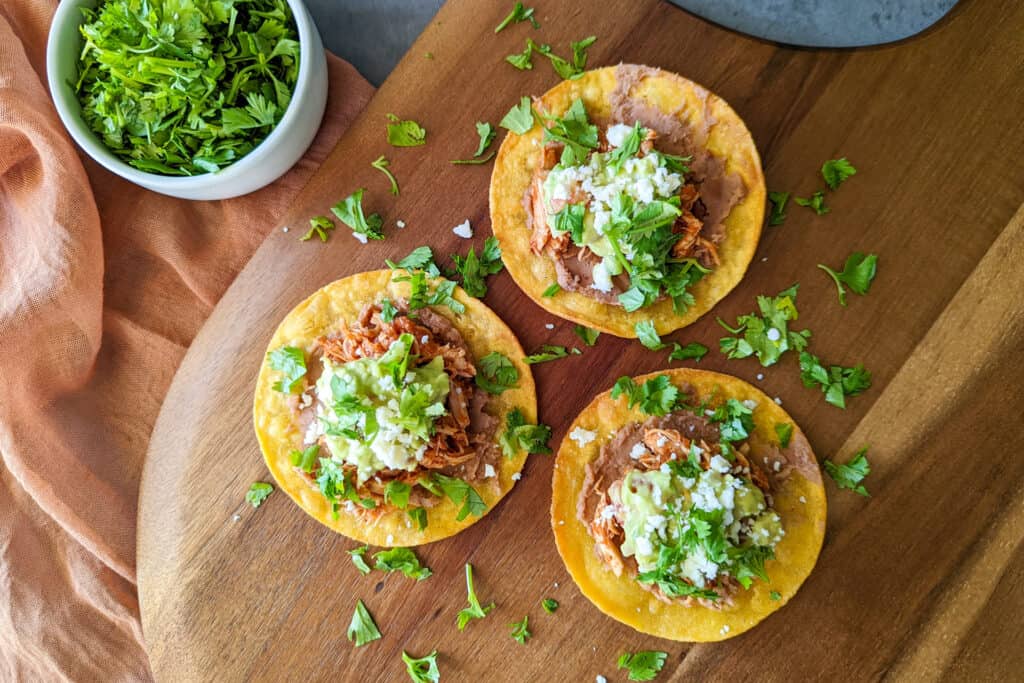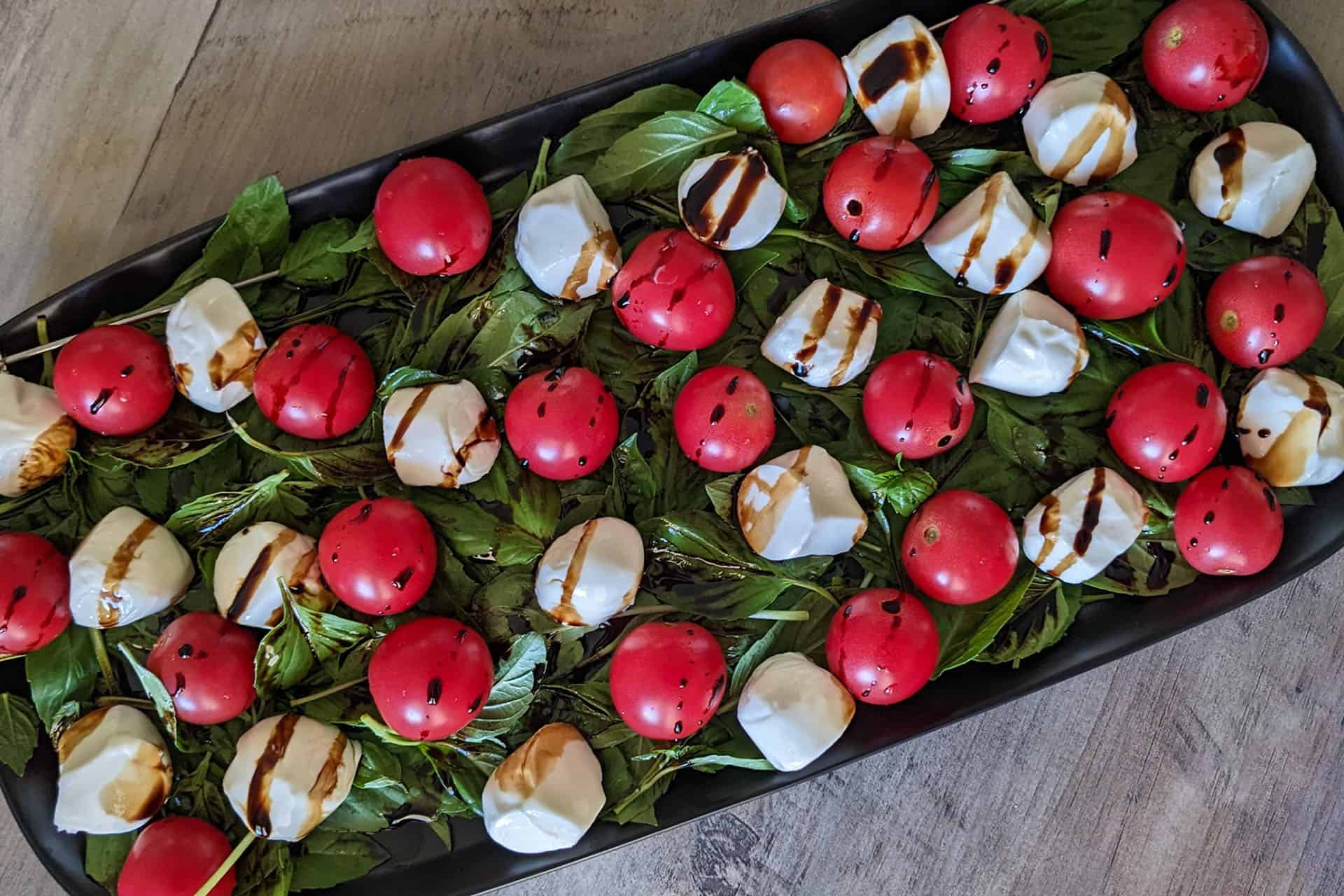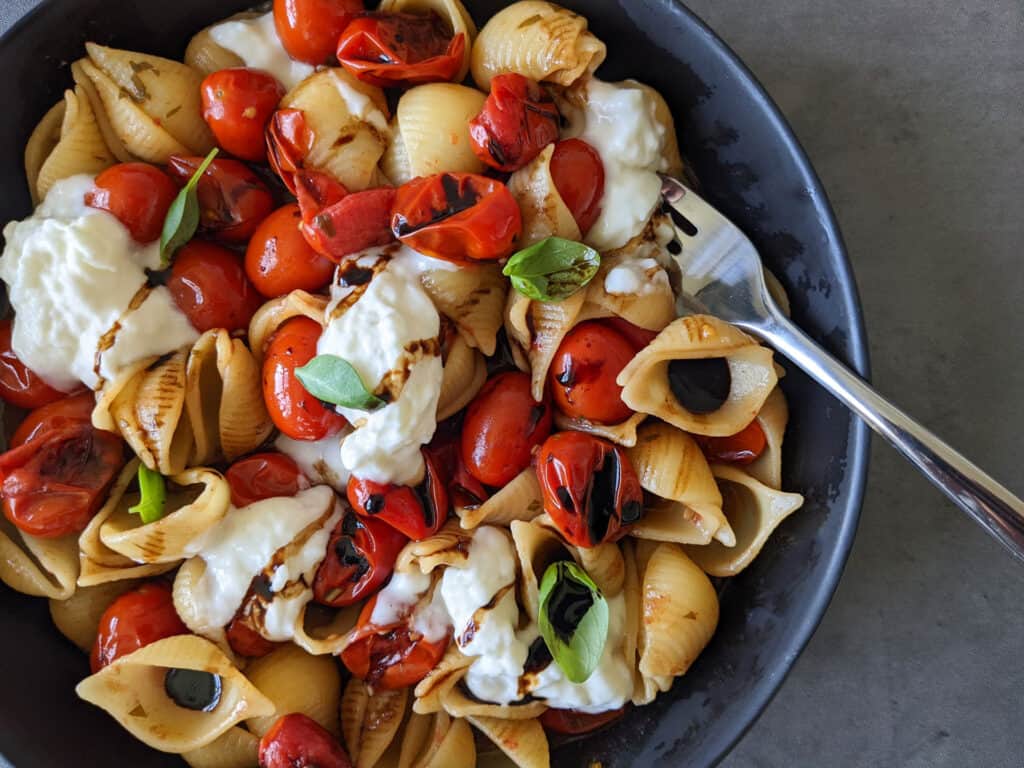Plating and presentation is an integral part of how food is experienced – and enjoyed. Here are some of our best tips for home chefs looking to level up their plating skills!
This post may contain affiliate links. As Amazon Associates and through other affiliate programs, we earn from qualifying purchases if you click on a link – at no extra cost to you. We only promote products we actually use and truly love!
Plating and presentation is arguably one of the most important aspects of cooking. Sure, you want your food to taste good – but what we consider “taste” actually depends on our other senses. How your meal looks, smells, and even feels when you bite into it impacts your perception of flavor. This means that you can craft a particular experience through proper plating and presentation, which can enhance your enjoyment of the meal.
In more straightforward terms, this means you can make your food taste even better by simply plating it in a particular way. Cool, right?
So if you’re looking to take your cooking to the next level, consider your plating skills. If your plating isn’t where you’d like it to be, improving it is a surprisingly easy step that will make your meals that much more impressive!
We’ve learned about plating and presentation through both our experience in the kitchen and the countless MasterClass lessons we’ve watched by world-renowned chefs. While there are many factors at play when it comes to food presentation, we want to share our best advice for those just starting out – so we’ve outlined a simplified approach to improving your plating below. Keep reading to learn how you can easily transform your home cooked meals into beautifully plated restaurant quality dishes!
How To Easily Improve Your Plating
Enjoying handcrafted food is as much about the experience as it is about the flavors you taste. After all, you’ve put your time and effort into cooking a delicious meal – so why not enjoy the food for everything it has to offer?
That’s where plating and presentation comes in. To create the best experience possible for enjoying a homemade meal, there are a few things to consider:
- Taste
- Texture
- Aroma
- Ease of eating
- Visual appeal
Let’s take a deeper dive into each of these plating components below.
What To Consider When Plating Food
Taste
We all want to eat food that tastes good, right? Which means cooking with high quality ingredients and successfully following a recipe. But that’s not all there is to it – plating can actually impact taste in a big way. Not always in the sense of altering the exact taste of the dish, but by affecting the way the flavors are perceived.
Let’s say you’re making a healthy power bowl recipe with rice, beans, and veggies that you think would taste great with some fresh avocado and crumbled cheese. Great! That sounds delicious already. And it likely will be delicious, no matter how you assemble your bowl – but there are many different ways of plating this dish, and they’ll all yield slightly different results.
Here are two scenarios to consider:
- You combine the rice, beans, and veggies by mixing everything together. Then you top it with a dollop of mashed avocado in the center and sprinkle some cheese on top of the avocado.
- You fill the bottom of the bowl with rice, then top that with a mixture of beans and veggies. Instead of mashed avocado, you layer slices across the top of the bowl. Then you sprinkle cheese across the top.
Even though they don’t sound that different, these two variations on plating imply different ways of eating the dish. In scenario 1, all the substance of the bowl is mixed together so each bite is a medley of flavors. You can also choose, bite by bite, whether or not to scoop up the avocado and cheese. But in scenario 2, you have layers of flavors, and you’re almost forced to eat avocado and cheese in every bite. But you can choose whether or not to have rice in each bite, depending on how far down into the bowl you go.
These subtle differences in the way the food is consumed play a part in the overall flavor of the dish. When you plate so that all the flavors come together in every bite, the flavor of the dish is more consistent throughout the meal. But when you plate in such a way where you can pick and choose what goes into each bite, every bite is a little different and the meal is more dynamic.
So when it comes to plating, think about how you want the food to taste through the lens of how you would eat it. Do you want every flavor in every bite? Or do you want to pick and choose what flavors to scoop up so every bite is different?
Texture
If you enjoy watching cooking shows, you hear it all the time: balanced textures are a key component of a good dish. But how do you go about achieving this?
The good news is, if you’re following a decent recipe it likely already has a nice balance of textures and flavors. However, depending on the type of recipe, your plating could make or break this balance.
Let’s look at something like our chicken tinga tostadas, which have a lot of different textures going on. Much like tacos, tostadas can be fun for DIY dinner nights where everyone customizes their own meal. But if you want to serve up pre-assembled tostadas for your friends and family, knowing how to plate them with the proper balance of textures will level up your homemade dish to a restaurant quality meal. How’s that for impressive?
Good tostadas have crunchy shells with tender meat, creamy refried beans, and fresh toppings like avocado, queso fresco, and cilantro. You don’t want one texture overpowering the others – just imagine what your tostadas would taste like if you slathered a ton of refried beans on them and made the shells all soggy. Sure, it’s an extreme example. But you’d be surprised at how easy this is to overlook, especially when you love Mexican food so much that you just want to put as many toppings on your tostadas as possible 🙂
Part of plating for texture is deciding if you want all the different textures in every bite, or if you want more variation throughout the dish – much like plating with different flavors in mind. But you’ll also want to consider the balance of various textures, i.e. contrasting crunchy with creamy, tender with chewy, etc. So when plating something like chicken tinga tostadas, here are a few important things to consider:
- You want your tostada shell to remain crunchy – this provides nice contrast for the creamy beans and avocado and the tender meat. So be careful not to overdo any toppings that might make the tostada shell soggy.
- Refried beans have a mushy texture, which you don’t want too much of. A little goes a long way when it comes to creamy or mushy toppings.
- Similarly, the creaminess of mashed avocado tastes great paired with a crunchy tostada shell and tender chicken tinga. But when you’re using it alongside something with a similar texture like refried beans, you may want to go lighter than normal.
- Finally, the amount of chicken should be proportional to the amount of beans and avocado so that the flavors and textures of these three main components mingle in every bite.
Plating to achieve balanced textures is something that will come with practice (and taste-testing). Start with simple things like burgers, pizza, and tacos – recipes that can have a lot of toppings – and play around with different textures to see what you like. Remember that there’s no perfect way to plate a dish, so have fun with it! Cooking is all about expressing yourself through food and presenting it in a way that represents how you want it to taste.

Aroma
It might seem odd, but scents and smells definitely play into how you experience food. Obviously, if you don’t like the smell of something then you might not like how it tastes. But that’s not exactly what we’re talking about here – what we want to focus on is how we can take advantage of scents you do like to add to the experience of eating.
The funny thing about flavor is that it directly plays off of smells – about 80% of what you taste actually depends on what you smell! So you can essentially curate what a dish tastes like by playing into the aromas of the ingredients you choose. A great example of this is the mojito, a refreshing and minty cocktail. Bartenders often finish this drink with a bushy sprig of fresh mint so that the second you lift the glass to take a sip, the smell of mint hits your nose. The added scent amplifies the minty flavors in the drink by playing into your perception of taste. Pretty cool!
Here’s an example of how you can try this in your cooking. Let’s say you just cooked a delicious Italian dinner with fresh tomatoes, creamy burrata cheese, and balsamic vinegar. It would taste amazing as-is, but to really take this dish over the top you could garnish it with fresh basil leaves. Not only would this add a pop of color and fresh flavor to your dish (two other important components of plating), but smelling the strong scent of fresh basil with every bite of your meal will instantly transport you to the Italian countryside.
Ease of Eating
To address this often overlooked aspect of plating and presentation, ask yourself: is this going to be a pain in the butt to eat? If the answer is yes, then you might need to make some adjustments.
To plate food in a way that’s appealing but also enjoyable to eat, you’ll want to consider how you’re going to serve it. Is it a fork and knife dish? Then it’s okay to serve bigger chunks of meat or veggies. Is it a sandwich? Then you might want to slice hard-to-bite ingredients into smaller pieces before putting them on the sandwich. Is it a pizza loaded with toppings? Make sure it’s not so loaded that all the toppings fall off the second you pick up a slice.
And while sometimes the messiest food is the best food (like our favorite appetizer, buffalo wings), some dishes benefit from going the extra mile to cut down on the amount of effort required to actually eat the thing.
These are just a few examples to remind you that eating is an experience that depends heavily on how you present the food. To make eating as enjoyable as possible, you want to consider the entire experience – from how it tastes, feels, looks, and smells, to how you’re actually going to eat it.

Visual Appeal
They say you eat with your eyes first, so we’re playing into the perception of taste here again. Visual appeal is super important when it comes to plating! In fact, it’s probably the first thing that comes to your mind when you think about food presentation. So why are we talking about it last?
That’s a tricky question. The simple answer is that you should consider taste, texture, aroma, and ease of eating before addressing visual appeal. The more complicated answer is that all of these plating factors need to be considered equally and simultaneously – but that’s something that comes with practice and gets easier over time. So if you’re just starting out with improving your plating and presentation, here are the steps we recommend following:
- Consider the balance of flavors in your dish. Do you want all the flavors in every bite, or do you want each bite to be different?
- Consider the balance of textures in your dish. Again, do you want every texture in every bite, or do you want variety?
- Decide how to incorporate meaningful aromas into your dish. This is often achieved with garnishes.
- Don’t forget to consider how you’ll actually eat the dish. Do you need to pre-slice any components into bite-sized pieces? Or serve your main attraction with a dipping sauce on the side?
- Finally, bring all these components together in a visually appealing way.
Basically, deciding on the balance of flavors, textures, and scents will get you more than halfway to plating a visually appealing dish.
Let’s look at another example. Say you’re making that Italian pasta again, with tomatoes, burrata, and balsamic. You decide you want every bite to have all these flavors and textures, so you choose a pasta shape that allows you to easily scoop up all the ingredients at once. You’ve also now decided to include fresh basil, but more for the scent – you don’t want basil in every bite. Stop and think about how you would plate this dish to create the experience you want, and you’ll find there’s really only one answer:
- To get all the flavors and textures in every bite – Have roughly equal amounts of tomato and pasta, dollop the burrata evenly across the plate, and drizzle balsamic over the whole dish.
- To get the scent of fresh basil, but avoid tasting it in every bite – Garnish the dish with just a few whole leaves of fresh basil, maybe in the center of the plate.
Considering all these other factors, the visually appealing part of plating will start to come naturally.
While there are additional aspects of visual plating, like the color and preparation technique of your ingredients, the simplified approach outlined here is a great starting point! And once you’ve mastered the basics, you’ll be set up for success when it comes time to refine your skills even further.
Plating and Presentation: Conclusion
In summary, plating and presentation of food really comes down to one thing: how you want the meal to be experienced. Cooking is a way of expressing yourself through food, so we encourage you to take advantage of every opportunity to create a uniquely handcrafted dish! Whether you imagine certain flavors, textures, or aromas coming together with each bite of your meal, these plating choices enable a whole new level of control over the experience you’re trying to create. So go ahead and make your favorite recipe – but this time, pay attention to how your plating choices affect the final dish, and experiment with the techniques discussed in this post to see how you can enjoy food for all it’s worth.
If you’re looking to level up your plating skills, try making one of these recipes:
- Sweet Potato Black Bean Rice Bowl
- Burrata Pasta with Blistered Tomatoes
- Chicken Tinga Tostadas
- Cashew Crusted Fish Tacos
- Chorizo Sweet Potato Fry Pizza
If you have any questions regarding the information presented in this post, please refer to our Nutrition Disclaimer here.
Looking for kitchen inspiration? Head over to our shop to see what we cook with every day, plus recommendations for foodie gifts and eco-friendly products.






